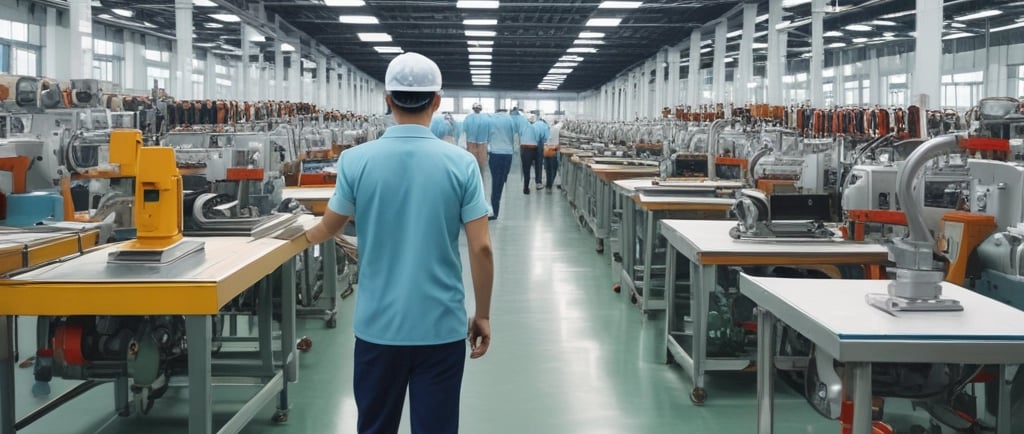How do you evaluate a supplier’s production capacity in China?
Sourcing Expert Allen Zeng
9/28/20254 min read


As a sourcing agent, evaluating a supplier's production capacity is essential to ensure that they can meet your business demands. This involves looking beyond simple factory size and equipment count and understanding the full scope of their operational efficiency.
To evaluate a supplier’s production capacity, I analyze several key factors, including their workforce, production processes, machinery, past performance, and use of technology to ensure they can meet deadlines and handle larger orders.
The goal is to not only assess their current capabilities but also their ability to scale up production when necessary. In the following sections, I will break down the different elements I focus on when evaluating a supplier's manufacturing capacity.
What factors influence your evaluation of a supplier's manufacturing capacity?
Evaluating a supplier's manufacturing capacity goes beyond just checking how many workers they have or how many machines are in place. I focus on a wide range of factors that paint a complete picture of their capability.
Key factors in evaluating a supplier’s manufacturing capacity include the size and efficiency of their workforce, the condition of their machinery, and their ability to manage fluctuations in demand.
Workforce and Skill Levels
I always assess the number of workers, but more importantly, I evaluate their skills and training. It’s critical to know whether the factory operates multiple shifts and how often workers are required to work overtime. Additionally, a well-trained workforce is essential for smooth operations and quality control.
Equipment and Machinery
The condition and maintenance of machinery are just as important as the number of machines available. I look at how well-maintained the equipment is and whether the factory keeps track of maintenance schedules. Regular breakdowns or inefficient machinery can significantly affect production timelines.
Supply Chain Reliability
The capacity of a factory to handle raw material shortages or delays can be a key factor in production. I evaluate how well suppliers manage their raw material inventory and whether they have alternative sources if something goes wrong. A reliable supply chain minimizes downtime and improves production flexibility.
Production Planning and Scheduling
It’s important to see how the supplier manages production schedules and capacity utilization. I review how they plan for peak seasons, the efficiency of their scheduling system, and how they adjust for unexpected demand increases. Efficient production planning ensures that deadlines are met without sacrificing quality.
How do you ensure suppliers can meet production deadlines?
Meeting production deadlines is crucial in any sourcing operation, and I ensure this by evaluating a supplier's workflow, lead times, and their past performance in meeting deadlines.
To ensure suppliers meet production deadlines, I closely monitor their past order history, assess their production planning processes, and conduct audits to verify their ability to scale operations efficiently.
Past Order History and Performance
One of the best indicators of a supplier’s ability to meet deadlines is their past performance. I request data on previous orders and analyze whether they met timelines, how many orders were delayed, and the reasons behind any delays. References from repeat buyers are also valuable to understand their consistency.
Trial Orders and Pilot Runs
To mitigate risk, I often suggest placing a smaller trial order before committing to larger quantities. This allows me to observe their process and ensure they can meet deadlines without compromising on quality. Pilot runs also provide valuable insights into the supplier’s throughput, turnaround time, and efficiency.
Production Scheduling and Lead Times
I ensure that the factory’s production schedule is realistic and that they factor in buffer times for unforeseen delays. I also review their lead times for both manufacturing and shipping, which helps me gauge whether they can handle urgent orders in the future.
How do you assess the scalability of a supplier's production?
When I evaluate scalability, I focus on whether the supplier can increase production capacity in response to growing demand without compromising quality or delivery times.
To assess scalability, I consider factors like production flexibility, workforce size, and the supplier’s ability to invest in new technology or facilities to expand output.
Flexibility and Agility
A scalable supplier should be able to adjust their production processes quickly based on your changing needs. I look at how easily they can scale production during peak seasons or in response to sudden changes in order volume. This requires both workforce flexibility and adaptable production systems.
Investment in Infrastructure
A supplier's ability to expand production often depends on their infrastructure. I evaluate whether the supplier is willing to invest in new machinery, hire additional workers, or expand their facility to handle increased demand. Suppliers who are open to expanding their infrastructure are better positioned to scale production in the future.
Technology and Automation
Technology plays a crucial role in scalability. I assess whether the supplier uses automated systems or advanced technologies that allow them to increase output without adding significant labor. Automation reduces human error, increases production speed, and improves overall efficiency.
What tools or metrics do you use to monitor production capabilities?
To keep a close eye on production capabilities, I use a combination of software tools, metrics, and on-the-ground inspections to ensure suppliers are meeting expectations.
The key tools I use to monitor production capabilities include production scheduling software, capacity utilization reports, and third-party audits to verify actual performance.
Production Scheduling Software
I rely on ERP (Enterprise Resource Planning) and MRP (Material Requirements Planning) systems to track production schedules and capacity. These systems provide real-time insights into lead times, production cycles, and inventory levels. By integrating these tools into my supplier monitoring process, I can quickly identify any issues that might affect production.
Capacity Utilization Metrics
Capacity utilization is one of the most important metrics for evaluating a supplier’s production capacity. This metric shows how much of a supplier's total production capacity is actually being used. By comparing actual output to maximum capacity, I can identify bottlenecks or inefficiencies. I also track machine uptime, downtime, and the reasons behind any interruptions.
Third-Party Reports and Audits
I regularly engage third-party audit services like SGS or Intertek to verify the accuracy of a supplier’s self-reported capacity. Independent audits provide an unbiased evaluation of the supplier’s actual performance. These reports give me assurance that the supplier is not overstating their capacity and can truly handle larger orders when needed.
Conclusion
Evaluating a supplier’s production capacity in China is about assessing not just their equipment and workforce, but also their ability to plan, scale, and meet deadlines. By using a combination of audits, historical performance analysis, and key metrics, I ensure that suppliers are capable of fulfilling your needs effectively.
Connect Us
Great partnerships start with a simple hello.
Quick chat
Explore
© 2025. All rights reserved.












